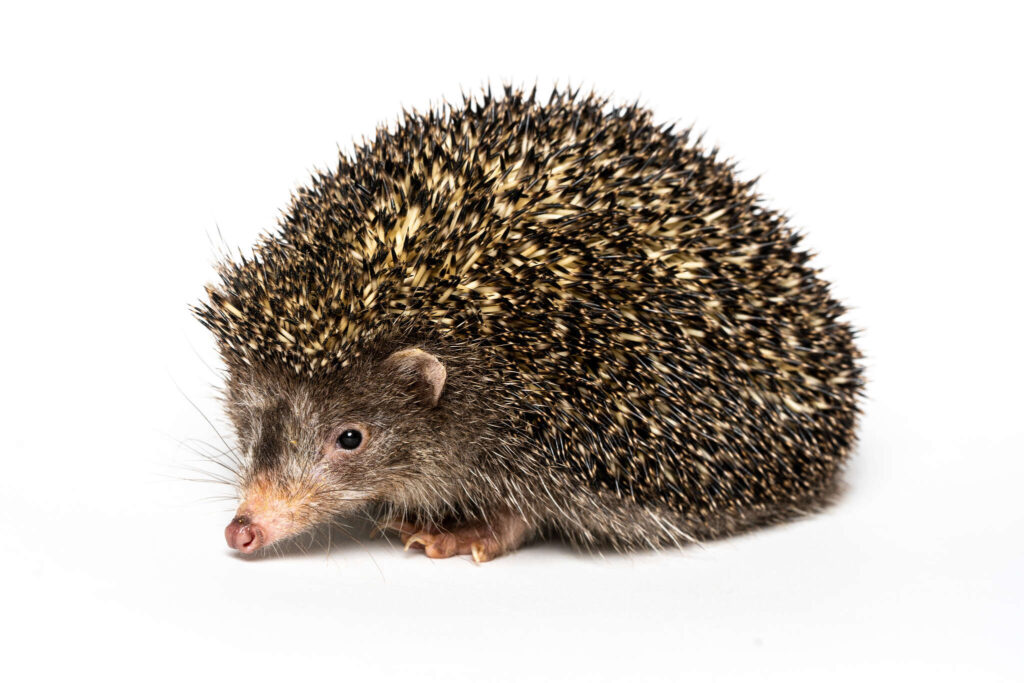If you cannot find the answer you are looking for, please contact us.
Small-toothed forest hedgehog

First described in 1910 by Thomas. Its most distinctive feature is its unusually small molars compared to other hedgehogs. It lives in forested regions of central China.
Taxonomy
| Kingdom: | Animalia |
| Phylum: | Chordata |
| Class: | Mammalia |
| Order: | Eulipotyphla |
| Family: | Erinaceidae |
| Genus: | Mesechinus |
| Species: | Mesechinus miodon |
Natural range & habitat
The Small-toothed Forest Hedgehog is native to parts of central China, with confirmed records from the provinces of Sichuan, Shaanxi, and Gansu. Its range is not fully mapped, and it may occur in other nearby provinces with similar habitats. This species inhabits montane and submontane forests, particularly broadleaf and mixed woodlands with dense understory vegetation. It is associated with cooler, moist environments compared to many other hedgehog species and is most often found in areas with ample leaf litter and natural ground cover for nesting and foraging. It appears to avoid open grasslands and heavily cultivated farmland, although it may be found along forest edges near rural settlements. Detailed habitat preferences, seasonal movement patterns, and altitudinal range remain poorly studied.
Physical traits
The Small-toothed Forest Hedgehog is a medium-sized hedgehog with a body length of approximately 18 to 25 centimeters and weights ranging seasonally from around 400 grams in spring to close to 1 kilogram before winter. It has a dense covering of spines on the dorsal surface, banded in shades of brown and cream, and coarse fur on the face, flanks, and underside that is generally brownish-grey. Its most distinctive morphological feature is the relatively small size of its upper molars, which gives the species its common name. The snout is moderately long and mobile, the ears are small and rounded, and the limbs are short but strong, adapted for digging. Seasonal fat accumulation is pronounced in preparation for hibernation. Sexual dimorphism is minimal, with males and females similar in size and coloration.
Behavior & lifestyle
The Small-toothed Forest Hedgehog is nocturnal and solitary, spending its nights foraging and its days resting in nests concealed under vegetation, in hollow logs, or in shallow burrows. It is an active digger and constructs both temporary shelters and more permanent winter nests. In colder parts of its range, it hibernates from late autumn to early spring, selecting insulated sites to protect against low temperatures. Activity levels and nightly travel distances are influenced by food availability and seasonal conditions. The species is generally non-aggressive toward conspecifics outside of the breeding season, but direct interactions are rare due to its solitary habits. Defensive behavior includes curling into a tight ball, raising spines, and producing hissing or snorting sounds.
Communication
As in other hedgehogs, communication in the Small-toothed Forest Hedgehog is primarily olfactory. Scent marking likely plays a role in territory maintenance and reproductive signaling, although this has not been directly studied in this species. Acoustic communication is limited to short-range sounds, such as huffing, grunting, or squealing, used during mating interactions, aggressive encounters, or distress. There is no evidence for complex vocal repertoires. Self-anointing behavior has not been recorded in this species but is present in closely related hedgehogs and may occur here as well. The species relies more on scent and hearing than on vision for navigating and detecting threats in its forested habitat.
Diet in the wild
The diet of the Small-toothed Forest Hedgehog has not been studied in detail, but it is presumed to be similar to that of other Mesechinus species. It is likely insectivorous and opportunistic, feeding on a wide range of invertebrates such as beetles, caterpillars, ants, termites, earthworms, and spiders. It may also consume small vertebrates, amphibians, and bird eggs when available, as well as seasonally available fruits or berries. Foraging is conducted primarily on the ground, using its keen sense of smell to locate prey beneath leaf litter or soil. Water intake is obtained mainly from moisture in food and from dew.
Reproduction & life cycle
Information on the reproduction of the Small-toothed Forest Hedgehog is lacking, with no published studies on its breeding season, litter size, or development. Based on related species, it is likely to breed in late spring or summer, with gestation lasting around 30 to 40 days and litters consisting of three to six young. The hoglets would be born blind and with soft spines, which harden within a few days, and eyes would open at approximately two weeks. Weaning would occur by four to six weeks, after which the juveniles disperse. Sexual maturity likely occurs within the first year, and lifespan in the wild is probably between three and five years, though this has not been confirmed for this species.
Threats & conservation status
The Small-toothed Forest Hedgehog is listed as Least Concern by the IUCN, but its population trends are poorly understood due to a lack of targeted surveys. Potential threats include deforestation, habitat fragmentation, and the conversion of forest to agricultural land. Road mortality and predation by domestic dogs may also pose localized risks. The species’ relatively restricted distribution within China could make it vulnerable to regional habitat loss. However, it is believed to occur within some protected areas, which may offer partial safeguards. Pesticide use in agricultural zones near its habitat may indirectly impact food availability and health.
This species in captivity
The Small-toothed Forest Hedgehog is not known to be kept in captivity outside of occasional short-term care in local wildlife rescue facilities. It has not entered the exotic pet trade, and no breeding programs are known in zoos or research centers. Captive husbandry requirements are undocumented, but would likely need to replicate cool, forest-like conditions with opportunities for digging and nesting, as well as a diet rich in live invertebrates. Seasonal cycles, including hibernation, would need to be accommodated for long-term welfare. Conservation of this species is currently best served through in-situ habitat protection and field research.
